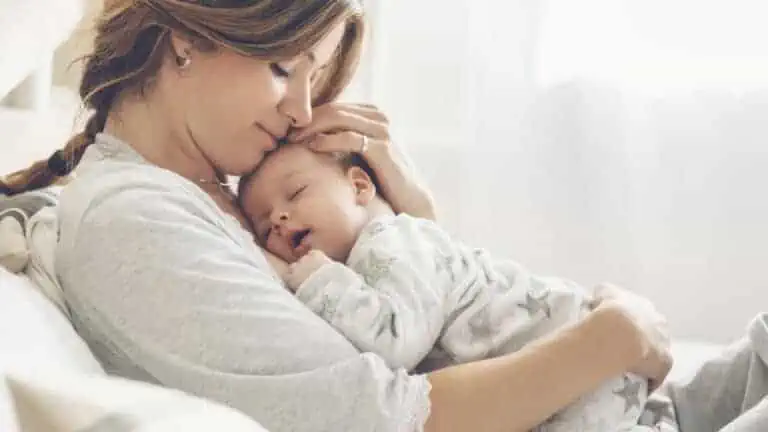7 Amazingly Gentle Postpartum Yoga Stretches For New Moms
This post may contain affiliate links. As an Amazon Associate, I earn from qualifying purchases.
After giving birth, new moms experience physical and emotional changes, ranging from sleep deprivation and mood swings to physical discomfort and pain. It’s all part of the roller coaster of motherhood as the body heals and life adjusts to a newborn baby.
Understandably, it becomes challenging to take care of a newborn and prioritize your own well-being simultaneously. However, taking care of yourself postpartum is crucial to promote healthy recovery and adjustment to motherhood. One effective way to boost recovery is through postpartum yoga.
This article will discuss the benefits of postpartum yoga, when to start, what to consider before starting, and seven safe and gentle yoga exercises you can include in your routine for a healthier and happier postpartum experience.
Benefits of Postpartum Yoga
Postpartum yoga can offer a range of benefits to new moms, both physically and mentally. Here are some of the benefits of postnatal yoga:
1. Relieves Stress and Tension
The stress of caring for a newborn and adjusting to motherhood can take a toll on a new mom’s physical and emotional health. Postpartum yoga can help reduce stress and tension by promoting relaxation and calming the mind. A study published in the International Journal of Preventive Medicine also proves that regular yoga practice can reduce perceived stress levels in new mothers. https://www.ncbi.nlm.nih.gov/pmc/articles/PMC5843960/
2. Improves Flexibility and Balance
Pregnancy and childbirth can cause changes in the body’s posture and alignment. And it’s proven that postpartum yoga poses can help improve posture, flexibility, and balance in new mothers as these movements gently stretch the muscles and release tension.
3. Promotes Physical Healing
In a 2016 study, researchers found that postnatal yoga can help strengthen the pelvic floor and abdominal muscles, aiding in postpartum recovery. It can also help alleviate common physical issues such as back and hip pain.
4. Boosts Mental Health
Postpartum depression and anxiety are prevalent among new moms. Yoga can help alleviate symptoms of postpartum depression and anxiety by promoting deep relaxation and reducing stress. [1]
Moreover, postpartum yoga can be a great way for new moms to connect with their bodies and practice self-care, as it allows them to focus on their physical and mental well-being, further promoting their confidence and empowerment in their postpartum body and recovery journey.
Related read: How to Be a Good Mother
When You Can Start Postpartum Yoga
Typically, new moms are eager to start exercising and getting back into shape after giving birth, but waiting until the body is healed at some level is crucial- even with postnatal yoga.
It’s recommended to wait at least 4 to 6 weeks after giving uncomplicated birth to begin any physical activity or exercise routine. Whereas those healing from a cesarean delivery may need additional time.[2]
Remember to talk to your doctor and get their approval before exercising. They can evaluate your physical health and ensure that you’re ready to start exercising safely.
What to Consider Before Starting Postpartum Yoga
Before starting postpartum yoga or jumping on a running treadmill to kill some fat, it’s essential to consider some safety tips to ensure you practice safely and effectively. Here are some things to keep in mind:
Start Slow
It’s crucial to start slowly and work your way up to more challenging poses. Remember to listen to your body and don’t push yourself too hard until you fully recover. This is especially true if you are struggling with pelvic floor dysfunction (incontinence, pain, etc.).
Focus on Your Breath
When doing yoga poses, whether in formal postpartum yoga classes or on your own, pay attention to your breath and try to breathe deeply and evenly throughout your pose. You may also want to focus on diaphragmatic breathing, also known as belly breathing, which helps promote relaxation and alleviate stress.
Modify as Needed
If a pose doesn’t feel comfortable or causes pain or discomfort, don’t hesitate to modify or skip it altogether. So, listen to your body in its postpartum period and only do what feels comfortable.
Use Props
Yoga props such as blankets, bolsters, and blocks can help provide support and make yoga postures and pose more accessible.
Work with a Professional
Working with a yoga instructor with experience working with postpartum women can be beneficial. They can help modify poses and develop a safe and effective exercise routine that meets your individual needs and goals.
7 Amazingly Gentle Postpartum Yoga Poses For New Mom
Source: Canva.com
Here are the seven safe and gentle postpartum yoga exercises. You can try them in a yoga class or on your own at home as part of a postpartum yoga routine.
1. Child’s Pose
The child’s pose is a restful and calming pose that gently stretches the hips and back muscles. It can help alleviate stress and tension and promote relaxation in the lower and upper body simultaneously.
How to do it:
- Start on all fours with your hands and knees on the mat.
- Then, lower your hips back towards your heels and reach your arms out in front of you.
- Rest your forehead on the mat and breathe deeply, holding the pose for 30-60 seconds.
2. Happy Baby
It is a gentle yoga pose that can stretch your inner thighs, hamstrings, and groin and release the hips and back, which helps increase your flexibility and mobility.
How to do it:
- Lie on your back with your knees bent and feet flat on the mat.
- Bring your knees towards your chest and grab onto the outsides of your feet.
- Then, gently pull your knees towards your armpits, keeping your feet flexed.
- Take deep breaths while holding this pose for 30-60 seconds.
3. Cat-Cow
Cat-Cow is a gentle yoga stretch that flows between two poses, increasing flexibility to the spine. It helps stretch the back and neck and softly stimulates the digestive tract while strengthening the abdominals.
How to do it:
- To begin, place your hands and knees on the floor. Keep your back and neck neutral.
- Inhale, arch your back, and lift your head and tailbone towards the ceiling (cow pose).
- Then exhale, slowly round your spine, and tuck the chin towards your chest (cat pose).
- Continue to alternate between the two poses for several breaths.
4. Gentle Spinal Twist
The gentle spinal twist effectively relieves tension in the back, hips, and shoulders. It also helps reduce tension and calm your mind.
How to do it:
- Sit on a mat with your legs extended in front and back straight.
- Bend your right knee and place your right foot outside your left knee.
- Then, place your left elbow on the outside of your right knee and gently twist to the right.
- Hold the pose for a few breaths, then repeat on the other side.
5. Forward Fold
The forward fold stretches the hips, hamstrings, and calves while keeping your spine strong and flexible. It can also relieve spine, neck, and back tension and gently activates abdominal muscles. Great for improving digestion and calming your mind.
How to do it:
- Sit on the floor with your legs extended in front of you and your spine neutral.
- Slowly bend forward from the hips, keeping your spine straight.
- Reach for your feet or ankles, or place your hands on the floor in front of you.
- Hold the pose for a few breaths.
6. Corpse Pose (with a focus on diaphragmatic breathing)
It is a relaxing and restorative pose that lets you release stress and quiet your mind. Corpse post may also help regulate your blood pressure and reduce muscular tension.
How to do it:
- Lie flat on your back, arms at your sides, and legs extended.
- Close your eyes and take slow, deep breaths, focusing on breathing deeply into your diaphragm.
- Relax your body and let go of any tension or thoughts.
- Stay in this pose for several minutes.
7. Bridge Pose
The bridge poses primarily target the glutes, pelvic floor, and lower back muscles. It’s a safe and effective pose for postpartum that can help improve core stability and digestive functions.
How to do it:
- Start by lying on your back with your knees bent and your feet hip-distance apart, flat on the ground.
- Your arms should be by your sides, palms facing down.
- Exhale, press your feet into the floor, and lift your hips toward the ceiling.
- Keep your shoulders and head on the ground, and maintain a straight line from your shoulders to your knees.
- Hold this position for several breaths, then slowly lower your hips back to the ground on an exhale.
- You can also modify the pose by placing a yoga block or pillow under your hips for additional support.
- Make sure to avoid excessive curves in the lower back.

What Not to Try
While postpartum yoga can be beneficial, avoiding any poses or exercises that can strain the abdominal muscles or pelvic floor is important.
Abdominal strainers like crunches, planks, and even certain yoga pose like bird dogs and downward dogs can put unnecessary pressure on the body. Plus, they can potentially worsen conditions like diastasis recti (until it has time to heal and recover with a focus on gentler poses during the postpartum period).
So instead, you should focus on gentle movements and poses (mentioned above) that can help you safely and effectively improve your physical and mental health.
Related read: Why Every Mom Needs Postpartum Physical Therapy
Conclusion: Be Gentle During the Postpartum Period
Postnatal yoga can be a safe and effective way for new moms to regain strength, flexibility, and overall well-being after childbirth. Incorporating gentle poses and movements can gradually build strength and stability in your core muscles without risking injury or strain.
Remember, it’s crucial to wait until the body is fully healed before starting a postpartum yoga practice and to talk to a doctor or midwife before beginning any physical activity.
With regular practice, postpartum yoga can help you feel more grounded, centered, and physically and mentally strong as you navigate the challenges and joys of motherhood.
Read Next: 23 Postpartum Recovery Tips To Heal Faster From Birth







